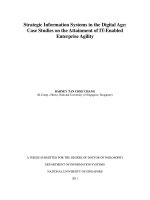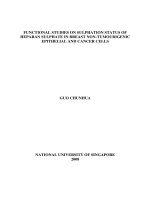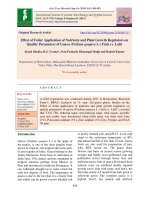Studies on species diversity of fruit flies and evaluation of pheromone lure longevity in guava (Psidium guajava L.) cv. Allahabad Safeda
Bạn đang xem bản rút gọn của tài liệu. Xem và tải ngay bản đầy đủ của tài liệu tại đây (117.72 KB, 7 trang )
Int.J.Curr.Microbiol.App.Sci (2019) 8(1): 2679-2685
International Journal of Current Microbiology and Applied Sciences
ISSN: 2319-7706 Volume 8 Number 01 (2019)
Journal homepage:
Original Research Article
/>
Studies on Species Diversity of Fruit Flies and Evaluation of Pheromone
Lure Longevity in Guava (Psidium guajava L.) cv. Allahabad Safeda
Afreen Tabasum*, Ch. Raja Goud, Veena Joshi, D. Anitha Kumari and A. Bhagwan
1
Department of Entomology, College of Horticulture, Sri Konda Laxman Telangana State
Horticulture University, Rajendranagar, Hyderabad-500030, Telangana, India
2
Department of Fruit Science, SKLTSHU, Rajendranagar, Hyderabad-500030,
Telangana, India
3
Vegetable Research Station, Rajendranagar, Hyderabad-500030, Telangana, India
4
Fruit Research Station, Sangareddy, Hyderabad, India
*Corresponding author:
ABSTRACT
Keywords
Guava, Fruit flies,
Pheromone lure,
Fruit fly traps
Article Info
Accepted:
17 December 2018
Available Online:
10 January 2019
Studies were carried out to determine the species diversity of fruit flies and pheromone
lure longivity was evaluated in guava orchard cv. Allahabad safeda at Fruit Research
Station Sangareddy. Randomized block design was followed for the experiment with 8
treatments and 3 replications. Initially all the traps were loaded with pheromone lure, later
the lure was changed from the traps at 30, 35, 40, 45, 50, 55 and 60 days interval. Various
parameters such as species diversity of fruit flies, number of fruit fly catches, number of
healthy and damaged fruits on the tree, weather data were recorded. Three species of fruit
flies viz., Bactrocera correcta, Bactrocera zonata and Gastrozona fasciventris were
identified. The number of fruit fly catches were highest in T 1 i.e when the lure was
changed at 30 days interval, with lowest number of damaged fruits and highest number of
healthy fruits against the tree without traps i.e., T8 (Control). When the weather parameters
were correlated with number of fruit fly catches and age of the lure it was found that there
was positive correlation with maximum temperature, minimum temperature, relative
humidity I & II however there was no correlation with rainfall and negative correlation
with wind velocity. Pheromone longevity in the traps was for 30 days.
Introduction
Fruit flies are considered as the key insects in
guava fruit production causing yield losses,
quarantine restrictions from importing
countries and quality degradation. Thus
pheromone traps are used to measure the
abundance and distribution of fruit flies in
guava. Fruit fly pests are members of the
family Tephritidae in the order Diptera and
they feed on hundreds of host plants leading to
poor commercialization in domestic markets
and quarantine restrictions from importing
countries. Tephritidae fruit flies are considered
a very destructive group of insects that cause
enormous economic losses in horticulture,
2679
Int.J.Curr.Microbiol.App.Sci (2019) 8(1): 2679-2685
especially in a wide variety of fruits,
vegetables and flowers. The guava fruit is
subjected to attack by several kinds of pests
and about 80 species of insects have been
recorded on guava, but only few of them have
been identified as pest of regular occurrence
causing serious damage.
flies. At first the oviposition marks are
difficult to detect but as within one or two
days the hatch, oviposition marks appear as a
distinct spot with a brownish patch around
puncture site.
Fruit fly infestations often spread quickly in
guava trees which produce sweet smelling
with an edible rind and creamy white, yellow
or pink flesh. When guava fruits ripe, these
emit a pungent, musky odour that attracts fruit
flies. Adult female fruit flies have a needle
like ovipositor with which they puncture the
skin of fruits to lay their eggs in the flesh.
Upon contracting the host, fruit flies lay their
eggs beneath the skin of fruit and the hatching
maggots feed on the flesh, and the resulting
damage causes guavas rotting due to microbial
decay of the flesh. When the guava fruit is
squeezed, the tiny punctures that leak juice
from surface indicate the infestation of fruit
The fruit fly traps were installed in the guava
orchard at Fruit Research Station, Sangareddy.
The tip of the traps was tied with help of string
on the branches on the guava trees. 15 cm
distance was maintained between the trap and
the branch. A total of 21 traps were used
which were loaded with the Bado-lure for
attracting the male fruit flies present in the
orchard at the time of fruiting. The lure was
changed at 30, 35, 40, 45, 50, 55 and 60 days
interval from the date of installation to
determine the longevity of pheromone lure.
Randomized block design was followed for
the experiment with 8 treatments and 3
replications.
Materials and Methods
Treatments
Treatments
Pheromone lure changed at
T1
T2
T3
T4
T5
T6
T7
T8 `
30 days interval
35 days interval
40 days interval
45 days interval
50 days interval
55 days interval
60 days interval
Control
The lure i.e. methyl eugenol (1, 2-dimethoxy4 [2-propynyl] benzene) was used which was
placed inside the fruit fly trap. Observations
were recorded at weekly intervals from 42nd to
49th meteorological week.
Different species of fruit flies
The fruit fly adults that were collected from
the fruit fly traps were brought to the
Department of Entomology, College of
Horticulture, Rajendranagar and were
identified on the basis of their taxonomic
characters.
The species which were difficult to be
identified were sent to National Bureau of
Agricultural Insect Resources (NBAIR),
Bengaluru,
Karnataka
for
taxonomic
identification.
2680
Int.J.Curr.Microbiol.App.Sci (2019) 8(1): 2679-2685
Number of male fly catches
Results and Discussion
The fruit fly adults were collected from each
trap at weekly intervals from 42nd to 49th
meteorological week and were counted
manually. The average of three trap catches
was considered for each treatment.
The catches of fruit flies in 21 methyl eugenol
traps installed in guava orchard were recorded
at weekly interval from October (42 MW) to
December (49 MW) during the year 2017. The
trapped flies were studied for species
composition. The flies were identified based
on taxonomic characters. Three different
species of fruit flies were identified and their
taxonomic positions are given in Table 1. The
results were supported from the reports of
different guava growing areas in India which
indicated the prevalence of same genera
Bactrocera (Shukla and Prasad, 1985; Gupta
et al., 1990; Singh, 1997b and Bansode,
2009).
Correlation of fruit flies with weather
parameters
The weather parameters such as maximum and
minimum temperature, relative humidity,
rainfall and wind velocity were recorded at
weekly intervals from 42nd to 49th
meteorological week. The weather data was
collected from the Fruit Research Station,
Sangareddy to correlate with the adult fly
catches and to determine longevity of the
pheromone lure.
Fruit fly species
Bactrocera correcta
Bactrocera zonata
Similar results were reported
researchers given in the table below
by
the
References
Viraktamath and Babu (2003), Ravikumar and Viraktamath
(2006), Bansode (2009) and Uke (2009).
Carrol et al., (2002), Dale (2002), Gilani et al., (2002),
Khan et al., (2005), Patel and Patel (2005), Rajitha and
Viraktamath (2006), Ravikumar and Viraktamath (2006),
Bansode (2009) and Uke (2009).
The total average flies recorded during the
study was 0.45 (Table 2). Highest number of
flies was observed, when the pheromone lure
was changed at 30 days interval i.e. T1 (1.14).
While no flies were observed in T8 i.e. control
(without trap).
However there were fluctuations in the
population of fruit flies because of changes in
the weather conditions. When the lure was
changed at 35 days interval there was decline
in the population of fruit flies.
Table.1 Different species of fruit flies identified during October-December 2017
Fruit fly species observed
Bactrocera correcta
(Bezzi)
Bactrocera zonata
(Saunders)
Gastrozona fasciventris
(Macquart)
Family
Tephritidae
Sub family
Dacinae
Genus
Bactrocera
Species
correcta
Tephritidae
Dacinae
Bactrocera
zonata
Tephritidae
Dacinae
Gastrozona
fasciventris
2681
Int.J.Curr.Microbiol.App.Sci (2019) 8(1): 2679-2685
Table.2 Number of male fly catches recorded at weekly interval during October to December, 2017
Treatments
Standard week
42
43
44
45
46
47
48
49
T1 (lure changed at 30 days
interval)
T2 (lure changed at 35 days
interval)
T3 (lure changed at 40 days
interval)
T4 (lure changed at 45 days
interval)
T5 (lure changed at 50 days
interval)
T6 (lure changed at 55 days
interval)
T7 (lure changed at 60 days
interval)
T8 (Control)
1.66
1.66
1.66
2.00
0.83
0.63
0.33
0.33
0.33
0.66
1.33
0.33
0.33
0.00
0.00
0.00
0.33
1.66
0.66
0.00
0.16
0.00
0.00
0.00
1.66
1.00
0.66
0.34
0.00
0.33
0.00
0.00
1.66
0.66
0.33
0.00
0.17
0.00
0.00
0.00
0.66
1.66
0.00
1.00
0.66
0.00
0.00
0.00
1.33
0.00
0.66
0.66
0.49
0.00
0.00
0.00
0.00
0.00
0.00
0.00
0.00
0.00
0.00
0.00
SE(m) ±
0.011
0.010
0.008
0.008
0.007
0.004
0.001
0.001
C.D at 5%
0.035
0.032
0.024
0.023
0.021
0.013
0.004
0.004
2682
Int.J.Curr.Microbiol.App.Sci (2019) 8(1): 2679-2685
Table.3 Correlation between weather parameters and fruit flies at weekly intervals
Weather
parameters
T1
T2
T3
T4
T5
T6
T7
T8
Maximum
temperature
Minimum
temperature
Relative
humidity I
Relative
humidity II
Rainfall
Wind
velocity
0.779
0.544
0.702
0.868
0.720
0.636
0.486
0.000
0.507
0.277
0.622
0.847
0.879
0.631
0.502
0.000
0.688
0.581
0.737
0.692
0.584
0.568
0.327
0.000
0.615
0.439
0.512
0.974
0.969
0.382
0.704
0.000
0.000
-0.626
0.000
-0.376
0.000
-0.780
0.000
-0.825
0.000
-0.772
0.000
-0.767
0.000
-0.374
0.000
0.000
2683
Int.J.Curr.Microbiol.App.Sci (2019) 8(1): 2679-2685
Peak activity of flies was observed in the T1
i.e. when the lure was changed at 30 days
interval. These results coincided with work on
population dynamics of fruit flies reported in
Gujarat by Dale (2002) and Bansode (2009)
and Karnataka (Rajitha and Viraktamath,
2006).
From the studies of influence of weather
parameter on overall population, it may be
concluded that fly population was directly
influenced by maximum and minimum
temperature, RH I and RH II, whereas no
correlation with rainfall and negative
correlation with wind velocity.
The correlation data have been presented in
Table 3. This indicates that increase in
temperature (maximum and minimum),
relative humidity (I and II) increases the fruit
fly population and vice versa while decrease
in wind velocity increases the fly population
and vice versa. The findings are in
confirmation with the reports of Sarada et al.,
(2001b), Dale (2002), Bansode (2009).
It can be concluded that three species of fruit
flies viz., Bactrocera correcta, Bactrocera
zonata and Gastrozona fasciventris were
identified in the guava ecosystem and
pheromone longevity in the traps was for 30
days.
References
Bansode, G.M., Patel, Z.P. and Shinde, C.U.
2009.
Comparative
biology
of
Bactrocera dorsalis (Hendel) on major
fruit crops of Gujarat. Pestology,
33(11): 21-24.
Carrol, L.E., White, J.M., Friedbery, A.S.,
Morrbom, A.L., Dalliwitz, M.J. and
Thompson, F.C. 2002. Pest fruit flies of
the world. Description, Illustrations,
Identifications
and
Information
Retrieval. Version 8th.
Dale, N.S. 2002. Studies on biology of
Bactrocera zonata (Saunders) and
management of fruit flies in mango
orchards.
M.Sc.
(Agri.)
Thesis
(Unpublished) submitted to Gujarat
Agricultural University, S.K. Nagar.
Gilani, W.A., Tariq, B. and Mohammad, I.
2002. Studies on population dynamics
of fruit flies (Diptera: Tephritidae) in
guava and nectrin orchard in Islamabad.
Pakistan Journal of Biological Science.
5(4): 452-454.
Gupta, D., Verma, A.K. and Bhalla, O.P.
1990. Population of fruit flies (Dacus
zonatus and D. dorsalis) infesting fruit
crops in North-Western Himalayan
region. Indian Journal of Agricultural
Science, 60(7): 471-474.
Khan, M.A., Muhammad, A., Waessem, A.
and Lee, L.L. 2005. Management of
fruit flies of the most perishable fruit.
Journal of Entomological Research,
35(2): 79-84.
Patel, Z.P. and Patel, M.R. 2005. Up-date on
work done in Integrated Management of
fruit flies in India. Presented in
Workshop at “The Magestic, Goa", 6-7
Oct. pp. 22.
Rajitha, A.R. and Viraktamath, S. 2006.
Monitoring of fruit flies in guava
orchard at Dharwad, Karnataka. Journal
of Agricultural Science, 19(1): 145-149.
Ravikumar, Ch. and Viraktmath, S. 2006.
Influence of weather parameters on fruit
fly trap catches in Dharwad, Karnataka.
Pest Management in Horticultural
Ecosystem, 12(2): 143-151.
Sarada, G., Maheshwari, T.U. and
Purushotham, K. 2001b. Seasonal
Incidence and population fluctuation of
fruit flies in mango and guava. Indian
Journal of Entomology. 63(3): 272-276.
Shukla, R.P. and Prasad, V.G. 1985.
Population fluctuation of Oriental fruit
fly, D. dorsalis in relation to host and
abiotic
factors.
Tropical
Pest
2684
Int.J.Curr.Microbiol.App.Sci (2019) 8(1): 2679-2685
Management, 31(4): 273-275.
Singh, S.P. 1997b. Fruit flies and their
management.
Indian
Horticulture,
42(1): 35-37.
Uke, N.S. 2009. Studies on species
composition and losses caused by guava
fruit fly, Bactrocera spp. in Pune
Region.
M.Sc.
(Agri.)
Thesis
(Unpublished) submitted to Mahatma
Phule Krishi Vidyapeeth, Rahuri
(India).
Viraktamath, S. and Babu, S. 2003. Species
composition and population dynamics
of fruit flies (Diptera: Tephritidae) on
guava. South Indian Horticulture, 52(16): 317-323.
How to cite this article:
Afreen Tabasum, Ch. Raja Goud, Veena Joshi, D. Anitha Kumari and Bhagwan, A. 2019.
Studies on Species Diversity of Fruit Flies and Evaluation of Pheromone Lure Longevity in
Guava (Psidium guajava L.) cv. Allahabad Safeda. Int.J.Curr.Microbiol.App.Sci. 8(01): 26792685. doi: />
2685









